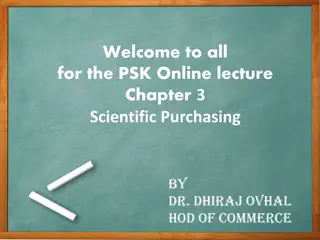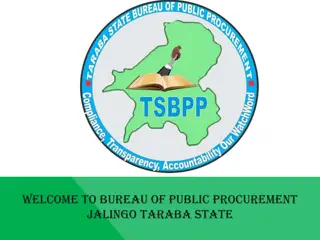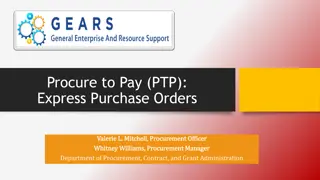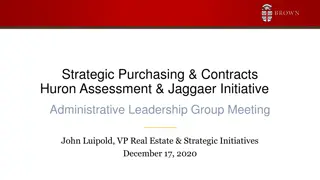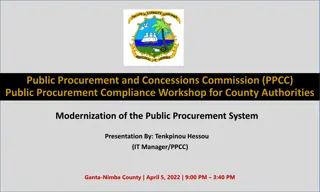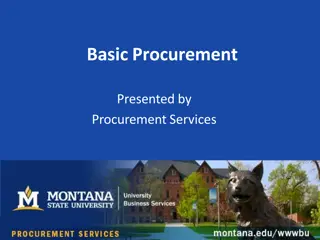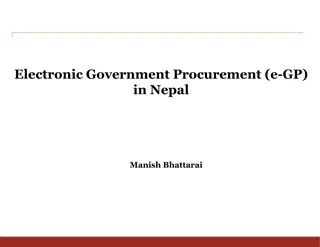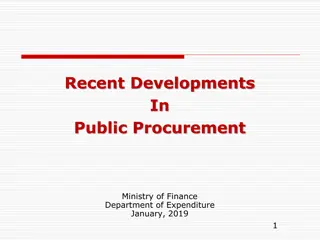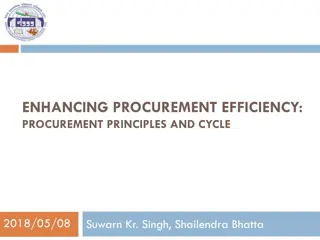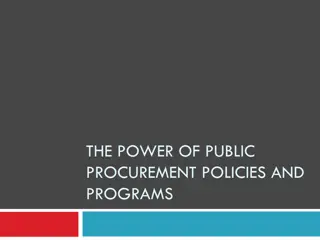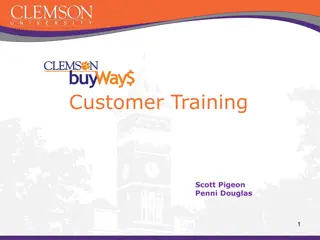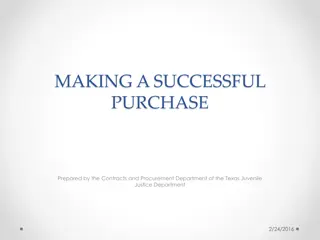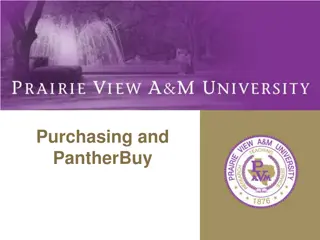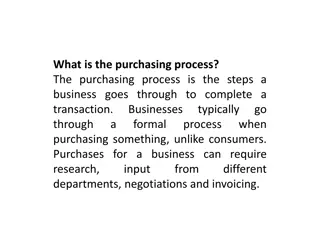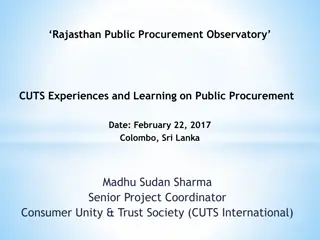Understanding Procurement and Purchasing Process for Business Efficiency
Procurement involves the complete process of engaging with suppliers, negotiating contracts, and obtaining materials, while purchasing focuses on acquiring goods and services. Effective procurement can provide competitive advantages by saving resources and optimizing operations. The purchasing cycle encompasses needs analysis, order placement, payment, and record-keeping. Automation and AI play a crucial role in streamlining the authorization process for purchase orders.
Download Presentation

Please find below an Image/Link to download the presentation.
The content on the website is provided AS IS for your information and personal use only. It may not be sold, licensed, or shared on other websites without obtaining consent from the author. Download presentation by click this link. If you encounter any issues during the download, it is possible that the publisher has removed the file from their server.
E N D
Presentation Transcript
Procurement is the process of contacting potential suppliers and negotiating a contract with them to buy goods or services for a business. Procurement and purchasing are often used interchangeably. However, while purchasing is limited to acquiring goods and services, procurement refers to the entire process, from identifying potential suppliers to negotiating contracts and obtaining raw materials. For businesses, procurement is of great importance. When done effectively, it can give the company a competitive advantage by saving money, resources, and time. Procurement also optimizes business operations.As a result, many companies involve the head of procurement in senior management. Procurement management is responsible for overseeing all the processes involved in acquiring the products, materials, goods, and services needed for efficient business operations.
Purchasing Purchasing is the act of buying the goods and services that a company needs to operate and/or manufacture products. Purchasing procedures are the series of activities designed to obtain products of the right quality and quantity at the right price and time and from the right source. Purchasing Cycle The purchasing cycle also called the procurement cycle or procure-to-pay (P2P) is the process by which you order, obtain, and pay for the goods and services your business needs. For companies of all sizes, from local small businesses to global megacorps, the purchasing cycle begins with needs analysis and ends with payment and record keeping. In between, they may generate a purchase order, pay for goods directly, or invite tenders (also known as bids) to encourage more aggressive and price-effective competition between suppliers wishing to fulfill a specific need.
NeedsAnalysis This stage of the purchase cycle is dedicated to identifying the need to be met, whether it s a reorder, raw materials for a new product produced by the company, or office supplies. Needs Clarification Once the need s been identified, the variety (e.g., brand), amount required, and delivery schedule need to be established. Purchase Requisition and/or Purchase Order With the details settled, the requesting party has a couple of options. Generally, those without the authority to approve direct purchase orders will first create and submit a purchase requisition, which is an internal document requesting that approved parties obtain goods and services. Upon approval, the purchase requisition is used to create a purchase order, which is the actual order sent to the supplier for the goods and services required.
Authorization The purchase order (generated from a purchase requisition or not) must also be approved. The purchase order process benefits from automation and artificial intelligence (AI), usually through the use of purchase order software that s part of a comprehensive procurement software package. Not only does automation permit role assignments and automatic routing and tracking of all purchase orders and approvals/rejections/revisions, but it allows for real-time adjustments and transparent communication between all parties involved. In addition, automatic reminders can be created to ensure no PR or PO is left to languish.
Supplier Review If you ve already integrated an automated procurement solution into your workflow, chances are the list of approved and available suppliers will obviate this step in the process especially for repeat orders. But if you re adding new products, or new suppliers for existing products to the system, then each candidate must be reviewed for compliance, performance, and reliability. Supplier Selection At this stage, the purchaser chooses the supplier who ll be filling the order, either from the pre-vetted list in their software catalog or through other means.
Price and Term Negotiations This step is also made infinitely easier if your workflow is built around procurement software automation. Centralized contract and document management and information sharing means previously negotiated contract terms and the best price are already available for each vendor on the approved list. New vendors being added to the system will have this information added as your legal team completes and certifies your company s agreement(s) with the vendor. If your company doesn t use automation, then your team will need to sit down with the vendor to negotiate payment terms and conditions.
Receiving and Inspection For material goods, arriving shipments are inspected for completeness and integrity, with any shortages and broken goods marked to be credited back to the buyer. The invoice is either included with the goods or sent separately by the vendor. Inventory management is either manually updated or handled automatically by the procurement software, which links the shipping documentation to the original purchase order, invoice, related correspondence, and other documents for data analysis and auditing purposes.
Payment The invoice is reviewed for accuracy against the purchase order, invoice, and other documentation. Depending on the terms established for the supplier and the approval of the reviewing party, payment is issued (usually within 30, 60, or 90 days). Records Management Businesses still using manual systems follow up by updating their inventory totals and purchasing ledger. Purchasing software automates this step, as documents are cross-connected and updated automatically across all departments.
Concepts of corporate farming Corporate farming, also known as agribusiness or industrial agriculture, refers to the practice of large-scale, commercial agricultural operations that are often organized as corporations or large business entities. This concept involves the management and operation of agricultural production on a significant scale, where the focus is on maximizing efficiency, productivity, and profitability. Scale of Operations Large Scale: Corporate farms typically operate on a large scale, often managing extensive areas of land for crop cultivation or livestock production. Economies of Scale: The large scale allows for economies of scale, where the per-unit production cost decreases as the scale of operation increases.
Capital Intensity Modern Equipment: Corporate farms heavily invest in modern agricultural machinery, equipment, and technology to enhance efficiency. Infrastructure Investment: Considerable investments are made in infrastructure, including irrigation systems, storage facilities, and processing plants. Specialization Crop Specialization: Corporate farms often specialize in cultivating specific crops or producing particular commodities. Livestock Specialization: Some corporate farms focus on large-scale livestock production, such as poultry, dairy, or meat.
TechnologicalAdoption Precision Agriculture: Corporate farming embraces precision agriculture technologies, including GPS-guided tractors, sensors, and data analytics. Biotechnology: Biotechnological innovations, such as genetically modified organisms (GMOs), may enhance crop yields or livestock characteristics. Global Presence International Operations: Corporate farms may operate globally, engaging in agricultural production, processing, and trading internationally. Supply Chain Integration: Some corporate farms integrate vertically into the supply chain, participating in processing, packaging, and distribution.
Input Intensity Use of Inputs: Corporate farms often use high inputs such as fertilizers, pesticides, and herbicides to maximize production. Hybrid Seeds: Hybrid seeds and other advanced agricultural inputs are commonly employed. Contract Farming Arrangements with Farmers: Corporate farms may enter into contracts with independent farmers, specifying terms for production, quality, and pricing. Risk Sharing: Contract farming provides stability and helps in risk-sharing between the corporate entity and individual farmers.
Efficiency and Cost Reduction Profitability Focus: Corporate farming strongly emphasises cost efficiency and maximizing profits. Operational Optimization: Strategies are implemented to optimize operations, reduce wastage, and streamline processes. Environmental and Social Concerns Sustainability: The environmental impact of corporate farming, including concerns about soil degradation, water usage, and biodiversity loss, has raised sustainability issues. Community Impact: Social concerns may include the impact on rural communities, employment practices, and the consolidation of agricultural land.
Government Policies and Regulations Influence of Policies: Corporate farming operations are influenced by government policies related to agriculture, trade, land use, and environmental regulations. Policy Advocacy: Corporate farming entities may advocate to promote their interests and align regulations with their business goals. Corporate farming has contributed to increased agricultural productivity and meeting the growing demand for food globally. However, it also raises questions and debates regarding sustainability, environmental impact, rural livelihoods, and the concentration of power in the agricultural sector. Balancing the economic benefits of corporate farming with social and environmental considerations remains a complex challenge.



